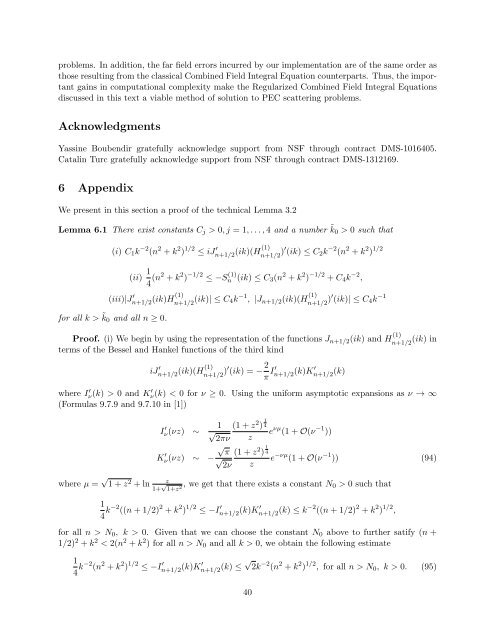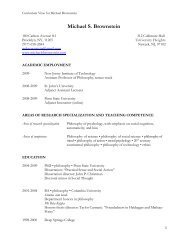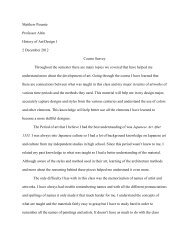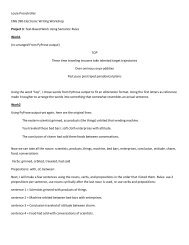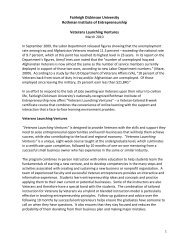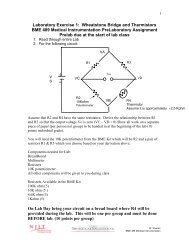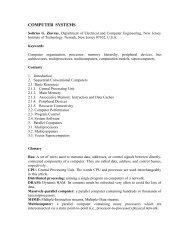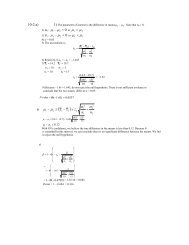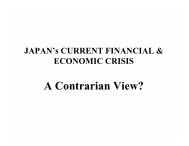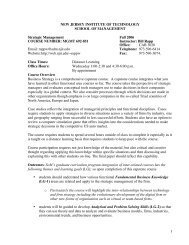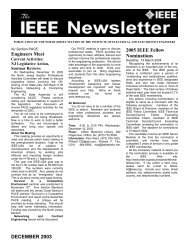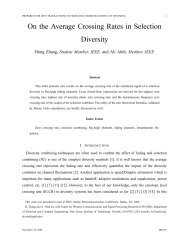Well-conditioned boundary integral formulations for the ... - Njit
Well-conditioned boundary integral formulations for the ... - Njit
Well-conditioned boundary integral formulations for the ... - Njit
Create successful ePaper yourself
Turn your PDF publications into a flip-book with our unique Google optimized e-Paper software.
problems. In addition, <strong>the</strong> far field errors incurred by our implementation are of <strong>the</strong> same order as<br />
those resulting from <strong>the</strong> classical Combined Field Integral Equation counterparts. Thus, <strong>the</strong> important<br />
gains in computational complexity make <strong>the</strong> Regularized Combined Field Integral Equations<br />
discussed in this text a viable method of solution to PEC scattering problems.<br />
Acknowledgments<br />
Yassine Boubendir gratefully acknowledge support from NSF through contract DMS-1016405.<br />
Catalin Turc gratefully acknowledge support from NSF through contract DMS-1312169.<br />
6 Appendix<br />
We present in this section a proof of <strong>the</strong> technical Lemma 3.2<br />
Lemma 6.1 There exist constants C j > 0, j = 1, . . . , 4 and a number ˜k 0 > 0 such that<br />
(i) C 1 k −2 (n 2 + k 2 ) 1/2 ≤ iJ ′ n+1/2 (ik)(H(1) n+1/2 )′ (ik) ≤ C 2 k −2 (n 2 + k 2 ) 1/2<br />
(ii) 1 4 (n2 + k 2 ) −1/2 ≤ −S (1)<br />
n (ik) ≤ C 3 (n 2 + k 2 ) −1/2 + C 4 k −2 ,<br />
(iii)|J ′ n+1/2 (ik)H(1) n+1/2 (ik)| ≤ C 4k −1 , |J n+1/2 (ik)(H (1)<br />
n+1/2 )′ (ik)| ≤ C 4 k −1<br />
<strong>for</strong> all k > ˜k 0 and all n ≥ 0.<br />
Proof. (i) We begin by using <strong>the</strong> representation of <strong>the</strong> functions J n+1/2 (ik) and H (1)<br />
terms of <strong>the</strong> Bessel and Hankel functions of <strong>the</strong> third kind<br />
iJ ′ n+1/2 (ik)(H(1) n+1/2 )′ (ik) = − 2 π I′ n+1/2 (k)K′ n+1/2 (k)<br />
n+1/2<br />
(ik) in<br />
where I ′ ν(k) > 0 and K ′ ν(k) < 0 <strong>for</strong> ν ≥ 0. Using <strong>the</strong> uni<strong>for</strong>m asymptotic expansions as ν → ∞<br />
(Formulas 9.7.9 and 9.7.10 in [1])<br />
where µ = √ 1 + z 2 + ln<br />
I ν(νz)<br />
′ 1 (1 + z 2 ) 1 4<br />
∼ √ e νµ (1 + O(ν −1 ))<br />
2πν z<br />
√ π<br />
K ν(νz) ′ (1 + z 2 ) 1 4<br />
∼ −√ e −νµ (1 + O(ν −1 )) (94)<br />
2ν z<br />
z<br />
1+ √ 1+z 2 , we get that <strong>the</strong>re exists a constant N 0 > 0 such that<br />
1<br />
4 k−2 ((n + 1/2) 2 + k 2 ) 1/2 ≤ −I ′ n+1/2 (k)K′ n+1/2 (k) ≤ k−2 ((n + 1/2) 2 + k 2 ) 1/2 ,<br />
<strong>for</strong> all n > N 0 , k > 0. Given that we can choose <strong>the</strong> constant N 0 above to fur<strong>the</strong>r satify (n +<br />
1/2) 2 + k 2 < 2(n 2 + k 2 ) <strong>for</strong> all n > N 0 and all k > 0, we obtain <strong>the</strong> following estimate<br />
1<br />
4 k−2 (n 2 + k 2 ) 1/2 ≤ −I ′ n+1/2 (k)K′ n+1/2 (k) ≤ √ 2k −2 (n 2 + k 2 ) 1/2 , <strong>for</strong> all n > N 0 , k > 0. (95)<br />
40


